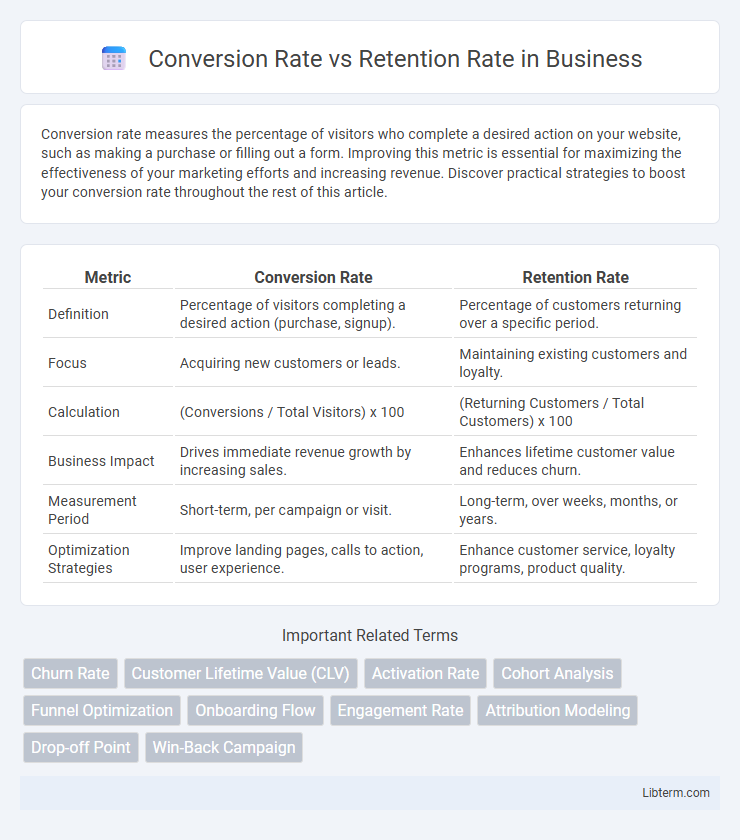Conversion rate measures the percentage of visitors who complete a desired action on your website, such as making a purchase or filling out a form. Improving this metric is essential for maximizing the effectiveness of your marketing efforts and increasing revenue. Discover practical strategies to boost your conversion rate throughout the rest of this article.
Table of Comparison
| Metric | Conversion Rate | Retention Rate |
|---|---|---|
| Definition | Percentage of visitors completing a desired action (purchase, signup). | Percentage of customers returning over a specific period. |
| Focus | Acquiring new customers or leads. | Maintaining existing customers and loyalty. |
| Calculation | (Conversions / Total Visitors) x 100 | (Returning Customers / Total Customers) x 100 |
| Business Impact | Drives immediate revenue growth by increasing sales. | Enhances lifetime customer value and reduces churn. |
| Measurement Period | Short-term, per campaign or visit. | Long-term, over weeks, months, or years. |
| Optimization Strategies | Improve landing pages, calls to action, user experience. | Enhance customer service, loyalty programs, product quality. |
Introduction to Conversion Rate and Retention Rate
Conversion rate measures the percentage of visitors who complete a desired action, such as making a purchase or signing up for a newsletter, indicating the effectiveness of marketing efforts. Retention rate reflects the proportion of customers who continue to engage with a product or service over time, signaling customer satisfaction and loyalty. Both metrics are essential for evaluating business performance, with conversion rate focusing on acquisition and retention rate emphasizing long-term engagement.
Defining Conversion Rate
Conversion rate measures the percentage of users who complete a desired action, such as making a purchase or signing up for a newsletter, out of the total visitors. It serves as a key indicator of a marketing campaign's effectiveness in turning prospects into customers. Compared to retention rate, which tracks how many users continue engaging over time, conversion rate focuses on the initial achievement of business goals.
Understanding Retention Rate
Retention Rate measures the percentage of customers who continue using a product or service over a specific period, reflecting long-term customer loyalty and satisfaction. Unlike Conversion Rate, which tracks the initial acquisition of customers, Retention Rate emphasizes sustained engagement and repeat business. High Retention Rates indicate effective customer relationship management and can lead to increased lifetime value and profitability.
Key Differences Between Conversion and Retention Rates
Conversion rate measures the percentage of visitors who complete a desired action, such as making a purchase, while retention rate tracks the percentage of customers who continue to engage with a brand over time. Conversion focuses on acquiring new customers or leads, whereas retention emphasizes maintaining and nurturing existing customer relationships for long-term loyalty. Businesses prioritize conversion for growth and retention for sustainable revenue, making these metrics distinct yet complementary in performance analysis.
Importance of Conversion Rate in Business Growth
Conversion rate directly impacts business growth by turning website visitors into paying customers, increasing revenue and market share. A higher conversion rate maximizes the returns on marketing investment by efficiently utilizing traffic and reducing customer acquisition costs. Focusing on conversion optimization drives scalable growth and sustains competitive advantage in dynamic markets.
The Role of Retention Rate in Customer Loyalty
Retention rate plays a crucial role in fostering customer loyalty by measuring the percentage of customers who continue to engage with a brand over time. Higher retention rates indicate strong customer satisfaction, leading to increased lifetime value and more predictable revenue streams. Prioritizing retention strategies enhances trust and encourages repeat purchases, which is often more cost-effective than acquiring new customers.
How Conversion and Retention Rates Impact Revenue
Conversion rate directly influences revenue by turning prospects into paying customers, driving initial sales volume and cash flow. Retention rate impacts long-term revenue growth through customer loyalty, repeat purchases, and reduced churn, increasing customer lifetime value. Optimizing both metrics balances acquiring new customers and maintaining existing ones, maximizing overall profitability and sustainable business success.
Strategies to Improve Conversion Rate
Boosting conversion rates involves optimizing website usability, implementing targeted calls-to-action, and personalizing user experiences based on behavioral data analytics. A/B testing landing pages and streamlining the checkout process reduce friction points that cause cart abandonment, directly increasing conversions. Leveraging customer feedback and integrating social proof such as reviews and testimonials enhance trust and encourage potential customers to commit.
Techniques to Boost Retention Rate
Boosting retention rate involves employing techniques such as personalized email marketing, loyalty programs, and exceptional customer service to enhance user engagement and satisfaction. Implementing in-app messaging and push notifications tailored to user behavior can drive consistent interaction and reduce churn. Leveraging customer feedback and data analytics helps identify pain points and optimize the user experience for long-term commitment.
Measuring Success: Balancing Conversion and Retention
Measuring success requires balancing conversion rate and retention rate to ensure sustainable growth. High conversion rates indicate effective acquisition strategies, while strong retention rates reflect customer loyalty and long-term value. Optimizing marketing efforts involves analyzing metrics like customer lifetime value (CLV) and churn rate to align conversion and retention goals.
Conversion Rate Infographic

 libterm.com
libterm.com